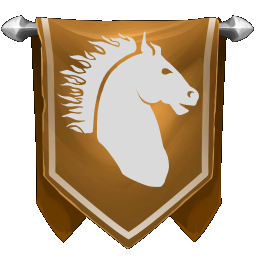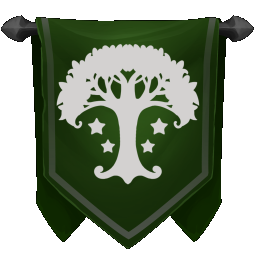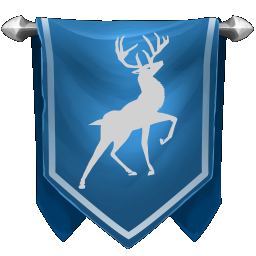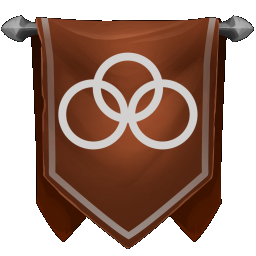M
Major Factions of Thain
The factions of Thain are a key part of the game experience, providing characters with a home city to which they can be loyal. Each city on Thain represents its own distinctive culture – different factions may rival or oppose one another, and characters are encouraged to emphasize these differences. Factions and their conflicts are a key part of Thain, and we encourage players to commit to the factions that most appeal to them.
Characters who choose to affiliate to a faction can receive a number of faction-specific rewards. These rewards are earned through completing faction quests, available from a faction representative within your major city. Each quest will earn you points within the faction system, and these points offer certain rewards.
25 Points: (Recognized) A character who is recognized within a faction holds no special sway over the faction, nor are they beholden to it, but does gain discounts from merchants in the location that faction is present in. A character may be recognized by any faction they are neutral to, but may only swear Allegiance and gain further Faction benefits with one.
25 Points: (Allegiance) Characters who have given their allegiance to a faction can now fast travel to that faction’s homeland once per rest, to ease the turning in of quests. This can be done using the /homeland command. Allegiance characters also qualify for settlement exclusive versions of “Magister” and “Knight” line of prestige classes: Each faction has a Magister and a Knight class designed specifically for them, and these classes gain special abilities distinct to their faction.
75 Points: (Welcomed) A character who is renowned within a faction is known, likely to higher-ups within the faction. Welcomed characters gain the ability to craft simple (armor type 0) clothing bearing the insignia of their settlement upon it, which can be further enchanted through crafting.
150 Points: (Esteemed) An esteemed character is well known for their value and heroic potential within a faction. They are the stuff of stories among their peers. Esteemed characters can wear their faction’s colors, crafting armor, shields, and cloaks with their faction’s respective insignia. They gain the ability to craft special faction armor, given specific statistics appropriate to their class and skill bonuses unique to the faction the character belongs to.
300 Points: (Renowned) A renowned character is one who has risen through the ranks of their faction and has gained sufficient notoriety to be granted land within the faction space. Characters with 300+ points may speak to their faction leader to receive a Faction Housing Key, allowing them to create and save an instanced player house within their faction’s lands.
Listed below are some of the factions of Thain. This does not include every settlement or order a player can join – it is merely the largest and most notable factions currently included in our faction system.
Steinkreis
“To rule is our responsibility.”
Steinkreis is the largest city on the island, with an estimated population of over a hundred thousand laboring souls. It is a city of broad economic strata – the laborers of lowtown work in businesses owned by wealthy Blackmere nobles for startlingly low wages. Yet in spite of the broad economic division, Steinkreis is one of the safest and most secure places on an otherwise perilous continent. The walls of Steinkreis have stood since the second age, when mighty Vongottstein’s technology, now lost, created all but paradise. The Steinkreis of today holds only a shadow of the nobility of Vongottstein – both figuratively and literally.
Among its ancient families, some trace their roots to those halcyon days. The city has been ruled for generations by the Kampfer line of kings – at least until today. Today the throne sits vacant, occupied by a steward named Bargus Telmoran and his council of noble advisors, after the king tired of courtroom intrigue and left in search of another great adventure. At its greatest, Steinkreis could aspire to be no mere walled fortress, but the lawful force of an island now beset on all sides, able to extend its protection to all the isle, in which its people all live in prosperous plenty. At its worst, Steinkreis is a laborious and disorganized mess of competing noble and economic interests that barely keeps its own borders safe. In the absence of a King, it seems nearly certain to trend toward the latter.
Feywood
“The lost can be regrown.”
The Feywood stronghold was once one of the most beautiful and enchanting places on all of Thain. Settled by the elves of the Second Age who fled the ruins of Elissara during the rise of the Rift, the byproduct of the Elven Schism was a heart of elvendom in the North. The wondrous Northwood concealed itself from the comings and goings of the high technology of the Second Age through bargains struck with the Fey, who lived in those ancient lands long before the arrival of the elves. Many of these bargains afforded them protections – ultimately culminating in the utter destruction of the neighboring tribes of humans living in the Gerdameshian Taiga – an act the elves of today still swear was done in self defense.
Protections given by the fey come with prices however – while the Feywood elves live in pure elven simplicity, often shielded from the outside world, they have attracted time and again the attentions of Dark Fey – fell fairy courtesans whose grim bargains have gradually darkened the wood. Additionally, a number of terrible conflicts have decimated the numbers of the elves in Feywood, and now a fraction of a once proud people live in an ever vanishing, ever darkening wood. The remaining Feywood elves, many fairy-pacted and observing the archfey as near-deities, strive ever for new growth and the banishment of darkness, webs, and men from their wood
Hamley
“The wild calls.”

The northern farmlands of Hamley stretches a great many miles from the North road, nestled in the shadow of the great northern woods and the Grey Iron Mountains. It is the enduring legacy of human resilience, once an independent state, now owned and sparsely protected by Steinkreis. Of late, the election of Hamley’s first mayor in generations – Huren Dael – saw the exodus of Hamley’s longtime defenders, the Empyrean Templars.
The Hamley of today is an ever-pressed farming settlement ringed in dangers, beset by superstition. To the East, suspicious farmers fear (and often deal) with the fairies of the Feywood. To the north, the Adumbral forest’s many dangers threaten the enclosed town’s walls, and farms outside of them are protected by roving horseback bands of Hamley’s militia: The Outriders. On all sides, Hamley knows danger, and it is kept at bay through the ever beleaguered efforts of bands of Rangers, Druids, and the Bloodguard of Castra Aurelia.
In spite of their ever over-taxed protection, every man and woman of Hamley must see after their own welfare, often through deeply communal efforts, and it is only the work of a moment for whole farms to be undone. The temptations of the woods and the wilderness are everpresent, the allure of the fey high, and among the people of Hamley, one thing is certain: to the unsuspecting, the wild calls.
Hammersong
“Stone and word endure.”

Long ago in the far Northlands, it is said the ground was split open by the great Titans, and the first Dwarves emerged from the valleys, digging upward from some unknown depths. The first age saw fellowship with the other children of the titans – the Giants. Many Dwarves came south in this time, befriending Frost and Fire Giants and swearing ancient oaths as the two shared craft and fellowship. During this time they settled a new home, Zirak’shathûr in their secret tongue, “The Cloud-spike”; but from the ringing of the anvils and the fires of the forge, all the island came to know the place as “Hammersong”.
In the ages to follow, the unchecked high magics of the first age transformed the great North into an inhospitable and monster ridden wilderness, and contact with the ancient homes of the Dwarves was utterly lost. The rift’s corruption reached even the Giants, and bitter enmity was born forever after by Dwarves and the Giants who sought to enslave them for their craft. Today, Hammersong balances its trust in the wider isle against a lifetime of broken promises by others. Its recent alliance with Steinkreis and the construction of the Mithral Rail between the two cities is the subject of much consternation by older Dwarves, while younger ones led by the young King Rugar Greathammer XV try to forge new bonds and oaths. To the wider isle, an oath might last a lifetime, but to Dwarves it is eternal. Following the final closure of the Rift, the fires of Hammersong’s forges have begun to extinguish, and the last legacy of the Dwarves threatens to disappear entirely.
Greenvale
“The future becomes the past.”

One of the first great cities of Thain, Elissara was the city of Hope, a city of beautiful splendor and wonders during the First Age of high magic. The first-elves who settled the south coast reached deeply into the island’s magics, and through them they built a civilization that has never again been rivaled. The tragedies of the first emergence of the Rift and the fall of the First Age left Elissara an aging ruins as her survivors migrated northward, and it was only in recent times that the ruins were reclaimed, and Greenvale returned.
War has come to the city since between its neighboring southern Poisonwood, culminating in the decimation of a great swathe of neighboring wood and the creation of the ever smoldering Ashwood. The elves since have known many sorrows. Those few who remain alive dwell in the thousands in a city made for tens of thousands. It is a solitary life, and for elves it will stay solitary for many hundreds if not thousands of years. It is a dozen generations of rebuilding that balances upon a knife’s edge of extinction.
Yet for all the faults and dangers, it is a city that dares to hope. It looks forward to a future of renewed greatness – Elissara has been reclaimed once, and led by one of the last direct descendants of the first elves, Queen Yu’syu, the city looks forward once more. Of late, the elves have begun to lose more than numbers – in a city that has taken in many non-elven refugees, those elves who remain have mysteriously begin to lose their ancient memories. Rumors abound that it is living alongside outsiders that is to blame, and the city forever grapples with the balance of the reclamation of its greatness, and the costs of its generosity.
The Watch
“The strong do what they will. The weak do what they must.”
Once a small port fortress named Raven’s Watch, The Watch grew to prosperity and size on the back of its often illicit leaders. Under a man called Krel, Raven’s Watch grew in economic power, cornering the high seas and imposing strict tolls upon the Northern Roads, and carving out a legacy of piracy and strength-based wealth until his assassination. In the power vacuum that followed, the Watch saw a rebirth as Dragon’s Watch, a city of strange and often monstrous strength kept in check by Nayritha, the most infamous sorceress of the isle. It is not possible to keep monsters on a leash forever on Thain however – a lesson Nayritha learned harshly as the monsters of the Watch rose up to slay her.
The Watch that followed saw no clear leader – and perhaps the purest version of its vision has come to arise from the ashes. In the watch of today, anyone and no one could be the Lord of the Watch, and the Watch has seen itself divided roughly into three districts embodying the three philosophies of the Watch’s ever-growing obsession with strength and power. Powerful players have begun to arise to lay claim to these districts, their right to rule complicated by the Witchblight – the magical blight afflicting the whole of the Watch in the wake of Nayritha’s demise and the destruction of her tower. It is said that long-term inhabitants of the Watch are racked with terrible pain and afflictions by the Witchblight, and a remedy of ritual magical tattooing has been the only answer to this malady the town has seen, further dividing man and woman by district and tattoo. It is rumored throughout the land that the Witchblight often awakens monstrous mutations and terrible powers in the blood of those afflicted by it – such that any bearing the tattoos of the Watch would be likely pariahs in all but the least civilized of lands.
Craggen Village
“No walls. No boundaries.”

The youngest settlement of Thain, Craggen Village has only existed since the start of the Third Age. The village was settled by Arianna Kampfer, self-exiled daughter of the line of Kings of Steinkreis, and is protected by bands of Rikrjack, the ritually giant-blooded men whose impossible feats of strength keep the slim stockades standing and their sailing channels free of ice. It is a bleak and inhospitable land, one of frontier wilderness and ever evolving survival strategies.
The Great North joins the far western wastes as one of the only parts of Thain not to be broadly explored, and none know how far it might stretch beyond the unnavigable ice fields. In the great Northern expanse, there are no former nationalities – men bearing tattoos of the Watch might work a ship through the ice alongside hin exiles of the South coast. Common cause and survival lay claim to the highest priorities of those few survivors who inhabit the plains, and only monstrous humans and troublemakers are turned away at swordpoint for deepening rather than alleviating some of the dangers of the wilderness.
The tribes of the north are many-fold, and rarely join under one banner, but it is said that some look kindly upon the Craggen villagers. Barbarians by the reckoning of most southerners, they have inhabited the land since before Craggen was built, and while some admire the temerity that the immigrants of more civilized lands present in the face of the ever-winters of the North, others fear usurpers who bring strange magic and their own brand of civilization that might ultimately lay claim to their homes.
The Iron City
“Where every wish comes true.”

The origins of the Iron City are shrouded in mystery – some believe that the King of Karistad, a militant kingdom of the second age, attempted to stave off the promises he made the rift by making deals with an archdevil of the hells. Others tell of a migration from a fiery isle off the west coast. Whatever the origins, life in the city itself is as great a mystery to an outsider. Rumors abound of devils sitting upon the Iron Senate – policing their city and its vices in a vise-like grip with merciless Hellknights and everpresent inquisitors. It is a city of absolute law and order, and one that few would visit save for the startling realities of the city.
The city of the iron is clean. It is crimeless. Its people do not want. Its beauty is often breathtaking. The source of all this idyllic perfection is the subject of scholarly contention, but one thing is certain: in the Iron City, wishes do indeed come true. Women who dream of being great opera singers stand unparalleled in their performances, warriors seem destined to win their duels, and the sick are made healthy. On an island of everpresent dangers and few answers, what wouldn’t a man or woman give for this measure of peace?
Mora’Chel
“The Darkness always hungers.”

The drow of Mora’chel are a persistent foe to many of the more goodly factions of Thain. While the drow themselves are rarely seen on the surface, their schemes, raids, and machinations have an uncanny ability to affect even those who walk in the sun. Perhaps the greatest threat to Mora’chel comes from within, however, as the city is deeply and bitterly divided between two great houses. House Mora, who controls much of the city’s military might, is led by Matron O’sina Mora, a cruel and formiddable devotee to the dark goddess, as well as Archmage Brorn Mora, perhaps the most potent single mage on all of Thain.
But in recent times, another house has begun to grow. House Tarthe, led by the High Priestess Sabrae, yearns for the benefits that house Mora takes for granted- and in the underdark, the only law is that of strength, and so the two houses circle each other, looking for any sign of weakness to pounce upon and destroy their rivals.
Mora’chel is unwelcoming to all but the most cruel, and characters will find the city well-defended. The unwary traveler who stumbles upon the drow gates all-too-often finds their mistake prove fatal. But rumors suggest that for those willing to prove their loyalty to the drow, Mora’chel may become a place of refuge to those whom the island’s other factions would cast out- and there are surely boons to be had by a city so rife with powerful magic.
Sandburrow Bay
“Build back better.”

The tragedy of the South Coast began in the first age, when the great High Magics of the elves brought the ruin of the Rift not only upon the great city of Elissara, but upon much of the land around it. Nature, however, heals over the splinters left within it in often ugly and unexpected ways. One-such landscar is the Poisonwood, and another, further south still, is the strange and mysterious hollow of Lumenshire. The hin of the land once settled a place they called Davenport, later Davenshire – and in this place lived in relative prosperity unknown and unnoticed by the comings and goings of the big-folk of Thain, until the arrival of a warband of Thayan mages.
Davenshire was cruelly destroyed in the conflict, and through only a trick of magic, its inhabitants later rescued from their fate and the Red Mages utterly annihilated under the combined might of one of the hin’s sea-bands. Today the remnants of Davenshire live among the gnomes of Sandburrow Bay. They cohabitate in a strange marriage of gnomish technology and hin naval growth that makes their admiralty and fleet, led by Thayan-war-Hero Admiral Yarland, a rare equal for the Pirates of the Watch. Theirs is a settlement only now coming into its own, one of halfling sensibility and gnomish logic often in stark contrast to the spiritual, haunted, and ever ephemeral South Coast and its strange legacy of forgotten magic and ghosts of the past.



